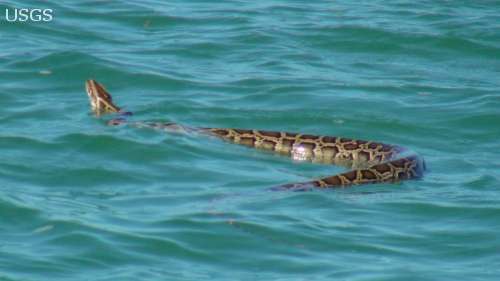Burmese Pythons as large as 20 feet lone have escaped from captivity, invaded the Everglades, and wiped out populations of mid-sized mammals. Python populations have expanded rapidly to nearly all of south Florida and now they are expanding north. These huge snakes thrive in urban and suburban environments where they may hide unobserved between feedings. The adaptable pythons are battling with alligators for the position of apex predator in south Florida.

Everglades alligator appears to be winning the battle with a Burmese python image credit:USGS
Road surveys totaling 56,971 km from 2003–2011 documented 9.3% decrease in the frequency of raccoon observations, decreases of 98.9% and 87.5% for opossum and bobcat observations, respectively, and failed to detect rabbits. Road surveys also
revealed that these species are more common in areas where pythons have been discovered only recently and are most abundant outside the python’s current introduced range.

Univ. of Florida photo of 15 foot, 162 pound Burmese python caught in the Everglades after it consumed a 6 foot long alligator.
North American mammals which have not faced predation by giant snakes for millions of years are apparently naive to the threat they pose. Invasive species like these snakes are able to expand populations rapidly because they have few natural enemies and prey are unwary. Even birds are threatened by the snakes which are known to climb trees. Endangered species which were rare before the snakes escaped into south Florida are now threatened with extinction.
Giant Burmese pythons have been seen swimming in open water in Florida Bay

Fishing guide Camp Walker, Catalyst Charters, of Islamorada, Fla., took this photo of a Burmese python swimming in Florida Bay from the end of Twisty Channel toward End Key on Nov. 16, 2011.
“People might argue the ultimate boundaries, but there’s no part of this state that you can point at and say that pythons couldn’t live here,” he said. “We really need to be addressing the spread of these pythons. They’re capable of surviving anywhere in Florida, they’re capable of incredible movement — and in a relatively short period.”Pythons are likely to colonize anywhere alligators live, he said — including North Florida, Georgia and Louisiana.
Burmese pythons have traits that increased their risk of establishment and that make their eradication difficult. Specifically, Burmese pythons:• grow rapidly to a large size (one over 16-feet long was captured in the Everglades in January 2012);
• are habitat generalists (they can live in many kinds of habitats);
• are dietary generalists (can eat a variety of mammals, birds and reptiles);
• may be arboreal (tree-living) when young, which puts birds and arboreal mammals such as squirrels and bats at risk and provides another avenue for quick dispersal of the snakes;
• are tolerant of urbanization (can live in urban/suburban areas);
• are well-concealed “sit-and-wait” predators (difficult to detect and difficult to trap due to their infrequent movements between hiding places);
• mature rapidly and produce many offspring (females can store sperm and fertilize their eggs —which can number more than 100 — when conditions are favorable for bearing young);
• achieve high population densities (resulting in a greater impact on native wildlife); and
• serve as potential hosts for parasites and diseases of economic and human health significance.As a result, Burmese pythons pose considerable challenges for the ecosystems of South Florida and many of the animals that live there, including threated and endangered species. Federal and state agencies or institutions are working hard to deal with the serious threats caused by this invasive species. USGS research aims to help managers preserve and restore the Everglades’ ecosystems.
Government land managers are trying to stop the pythons from expanding to the Florida Keys and to central and northern Florida. However, because the pythons swim in open water and thrive in swamps and drainage ditches, stopping the pythons from spreading will be challenging.
Can the Everglades be Rid of These Pythons?The odds of eradicating an introduced population of reptiles once it has spread across a large area are very low, pointing to the importance of prevention, early detection and rapid response. And with the Burmese python now distributed across more than a thousand square miles of southern Florida, including all of Everglades National Park and areas to the north such as Big Cypress National Preserve, the chances of eliminating the snake completely from the region is low. However, controlling their numbers and preventing their spread are critical goals for South Florida land managers. For example, a number of Burmese pythons have been found in the Florida Keys, but there is no confirmation yet that a breeding population exists in the Keys. Given a recent USGS study that showed the python’s apparent ability to disperse via salt water, island residents and resource managers need to stay vigilant so as to be able to detect and eliminate arriving pythons before they become established.
Burmese pythons should never have been allowed into the United States. On January 23 of this year the Fish and Wildlife Service placed a notice in the Federal Register prohibiting import and interstate transport of Burmese pythons, northern and southern African pythons, and the yellow anaconda. It's incredible it took so long to take this obvious step.
